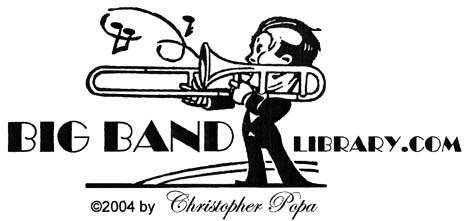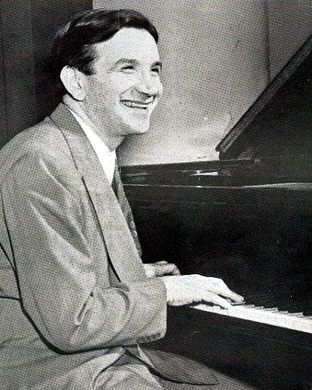
They made their first public performance on the "Saturday Night Swing Session," broadcast over CBS in December 1936, and recorded for Master, Brunswick, or Columbia during 1937-39.
He enlarged to a full-sized big band, as "Raymond Scott and His New Orchestra," beginning in the fall of 1939, staying on Columbia through 1941 and switching to Decca in 1942.
vital stats:
given name Harry Warnow
birth Sept. 10, 1908, Brooklyn, NY
death Feb. 8, 1994, North Hills, CA, pneumonia
heritage Russian
father Joseph Warnow, a diamond merchant and music shop owner
mother Sarah Warnow
brother Mark Warnow, an orchestra conductor, b.1900, d.Oct. 17, 1949, heart failure
education graduate, Brooklyn Technical School, Brooklyn, NY, 1927; graduate, The Institute
of Musical Art (which in 1926 had merged with the Juilliard Graduate School to become,
simply, the Juilliard School), New York, NY, 1931
first wife Pearl Zimney, m.1935, div. 1950
daughter
son
second wife Dorothy Collins, a singer, b.Nov. 18, 1926, m.1952, div.1965, d.Jul. 21, 1994
daughter
daughter
third wife Mitzi Curtis, m.1967
family 10 grandchildren
residences New York, NY; Long Island, NY; Van Nuys, CA
Though his playful riffs weren't considered major jukebox or dance hits, similar to other groups of the era, more than a dozen of his catchiest pieces, such as The Toy Trumpet and Powerhouse, were used starting in 1943 on the soundtracks of 115 Warner Brothers' "Merrie Melodies" and "Looney Tunes" shorts, featuring Bugs Bunny, Daffy Duck, Elmer Fudd, and Porky Pig.
More recently, Scott's tunes were heard as background music in Nickelodeon's animated series "The Ren & Stimpy Show" and in Fox's animated sitcom "The Simpsons."
Other Imaginatively-Titled Music By Raymond Scott - select list
Bird Life in the Bronx
Boy Scout in Switzerland
Bumpy Weather Over Newark
Caterpillar Creep
Confusion Among a Fleet of Taxicabs Upon Meeting with a Fare
Creepy Weepy
Dedicatory Piece to the Crew and Passengers of the First Experimental Rocket Express
to the Moon
Ectoplasm
Girl at the Typewriter
Huckleberry Duck
Oil Gusher
Pretty Little Petticoat
Serenade to a Lonesome Railroad Station
Take Me to Your Violin Teacher
Twilight in Turkey
The Wild Piece
With the use of early synthesizers and sequencers, Scott also became known as an electronics pioneer, creating (perhaps even preferring to make) music with machines rather than live people.
One of his first inventions was the "Orchestra Machine," an electromechanical synthesizer which he patented in 1946 and which could sound like the various instruments in a band.
His "Karloff," named after the horror movie actor Boris Karloff, came about in 1948 and simulated noises including kitchen clatter, jungle drums, honking, beeping, even a steak frying.
Another device, the "Clavivox" keyboard, patented in 1956, could imitate a human voice and woodwind or brass instruments. (A Clavivox was used on Tom Petty & The Heartbreakers' album, "Echo," in 1999.)
Raymond Scott - In His Own Words:
"I'd see a cow and I'd think, 'How can I portray that cow in music?"
"If I played something on the piano . . . and they picked it up on their instruments, it took on a
tremendous strength of feeling. They would hear the spirit and play back the spirit."
"The true way to be an artist is to write what you feel and hope you're lucky enough so that other
people like it, too."
"It is not widely known who invented the circuitry concept for the automatic sequential performance
of musical pitches - now well known as a sequencer. I, however, do know who the inventor was - for it
was I who first conceived and built the sequencer . . . I was so secretive about my development
activities - perhaps neurotically so . . . Now, with the passing of years, I guess I regret my secrecy and
would like for people to know of what I accomplished."
Though he supposedly thought the show was banal, Scott conducted the orchestra on the TV version of "Your Hit Parade," which aired on NBC from 1950 to 1957.
During the 1960s, he continued tinkering with electronics, building what he called an "Electronium," which, he claimed, could compose music by itself.
At the request of Berry Gordy, Jr., Scott headed Motown Records' electronic music division from 1972 until a serious heart attack forced Scott's retirement five years later.
Mark Mothersbaugh, co-founder of the new wave band, Devo, was said to have, at one point, purchased the "Motown version" of the Electronium from Scott's wife.
Amazingly, Scott continued to work at home, even while bedridden.
A major stroke in 1987 left him barely able to speak, and though he also suffered memory loss apparently he was still able to recognize his own music.
Happily, a reappraisal of his career, including a 1992 Columbia CD reissue which sold 15,000 copies in a year's time and an excellent "official" website created by Jeff E. Winner, showed to everyone that (besides his electronic machines) Scott had invented a lasting musical legacy.
sources:
Charles Garrod, Raymond Scott and His Orchestra (Zephyrhills, FL: Joyce Record Club,
1988).
Beth Kissinger, "The Man Behind the Loony Tunes," Chicago [ IL ] Sun-Times, Nov. 28,
1993, p.12.
Myrna Oliver, "Raymond Scott; Composed Quirky, Innovative Music," Los Angeles Times,
Feb. 10, 1994, p.24.
Maria Orlando, "Raymond Scott: A Pioneer of Electronic Music," Poptronics, May 2002,
pp.26-28.
Joel Whitburn, "Raymond Scott & His Orchestra," in Pop Memories 1890-1954: The History
of American Popular Music (Menomonee Falls, WI: Record Research Inc., 1986), p.378.
Jeff E. Winner, official Raymond Scott website, raymondscott.com.
Jeff E. Winner and Irwin D. Chusid, "'Circle Machines and Sequencers': The Untold Story
of Raymond Scott's Pioneering Instruments," Electronic Musician / emusician.com,
Dec. 1, 2000.
Michele Wood, ""The Men Who Made the Music: Raymond Scott," in The Swing Era
1937-1938 (New York City: Time-Life Records, 1971), pp.48-53.
I would like to expand this tribute, if possible, with a new interview of someone who was important to Raymond Scott's life and career. Are you an alumnus of her band, a member of her family, or a collector who is knowledgeable about her accomplishments? Please contact me via e-mail
return to "Biographical Sketches" directory
go to Big Band Library homepage
The big bands are back
in a new and exciting way!
RAYMOND SCOTT
"AN INVENTIVE MIND"
by Music Librarian CHRISTOPHER POPA
July 2009
He picked his stage moniker out of the New York City telephone book, thinking "it was a nice sounding name, it had good rhythm to it."
His off-beat style of music and the titles which he gave to his original compositions were more eccentric, such as Dinner Music for a Pack of Hungry Cannibals, New Year's Eve in a Haunted House, Reckless Night on Board an Ocean Liner, and War Dance for Wooden Indians.
Scott led what was referred to as a quintette (it was, in fact, a six-piece group, but he preferred that spelling of the term "quintet" to "sextet" and didn't count himself at the piano).
